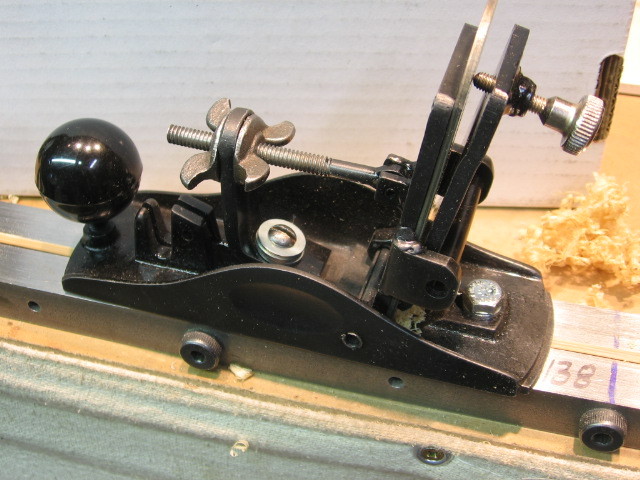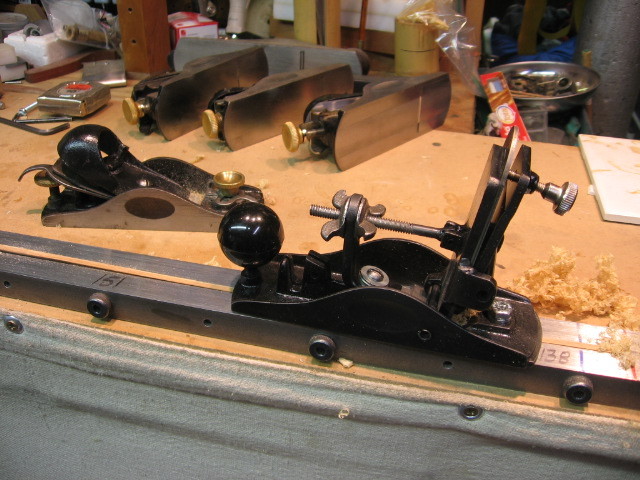Bamboo Tips - Tips Area |
|
< Home < Tips Area < Tools < Scrapers
This weekend one of those things that are so obvious in retrospect happened to me. I misplaced my cabinet scraper - the 4 x 6 rectangle of thin metal type of scraper. In rummaging through my drawers I came across the spare blade I bought for my Lie-Nielsen 212 scraper - Before anybody asks, sometimes I need to touch up a node that looks like it might chip, and I smooth it out with a cabinet scraper. Using the 212 takes too long because I have the blade adjusted to take off a very fine shaving for finish work, and adjusting it for a deeper cut means I will have to readjust it again when I need it for finish work. It is just much easier to grab a cabinet scraper and use it. So, I pick up the spare 212 blade, it's about 3 inches long, 1 1/2 inches wide and 1/8 inches thick - and use it by itself like a cabinet scraper. It works great used in that manner. It is so thick there is no flex, it is a lot easier to control, so much so that I can use it one handed. More pressure - more bamboo taken off, less pressure - very thin to very wispy shavings. No friction heat build up, at least none that gets to my fingers. The cabinet scraper can remain lost, I don't think I'll be using it anymore. (Darryl Hayashida)
Working on a rod today I was thinking about all the goodies I made or bought for rodmaking. I remember when I was in the process of getting my tools together the thought of investing a ton of money was overwhelming. I have had several hobbies in the past and one thing I learned is if you jump in with both feet you are apt to buy too much stuff and pay way too much for it. So before I started I did a lot of research and tried to find out where the best place to get my tools at the best price was. One stumbling block was buying a scraper. Essentially the Lie-Nielson scraper was the one recommended and basically was the only one in the game being its style is made only by one maker. I think it cost around $145, so I made my own. It worked O.K. but there is something that works even better. It never needs to be sharpened, can take a shaving of .0005 with great ease and the best part is it cost about $1.50. This marvelous tool is a good ole window scraper. I take my strips down to .005 above the forms with my grooved Stanley and then finish them flush with the scraper. Works every time. (Adam Vigil) When I first started I used the replacement blades for utility knives for scrapers. When they get dull, grab another. (Don Schneider) I still use single edge razor blades even with the Lie-Nielsen Scraper. Like you say, when dull just chuck them. Personally I have found this to be the best way for me to finish a strip. I do use cheap blades, Harbor Freight has them on sale at times for 1.97/100 blades. (Tony Spezio) I still use the blades to work on stubborn areas because I can take off very little per pass and see the results better. After the problem areas are straighten out I use the Lie-Nielsen Scraper to even things out. (Don Schneider) Same here. The L-N 212 makes much shorter work of the job. (Martin-Darrell)
I recently picked up a set of the handled triangular scrapers that Golden Witch sold a few years ago, and really like using them. I haven't tried it yet, but wonder how one might go about sharpening the scrapers. My guess is hold the edge flat on a stone or sandpaper, and rub side to side. Then flip and do the other sides. Anyone else fool with these things and have any words of wisdom? (Harry Boyd) As you anticipate, I sharpened by holding the tri-scraper flat on a 1000 grit waterstone. They are hollow ground, so go light, but it takes only a few passes to restore the edges. By the way, it's possible to leave almost invisible chatter marks, or perhaps very tiny ridges, with the tri-scraper, which show up under magnification (spotted it while wrapping). I've been puzzled by the cause on the occasional rod. The ridges do not occur with every blank. Now I look and finish with 600 grit sandpaper if it happens, but I like the tri-scraper better than sandpaper or filing - after the string and most of the glue is removed. (Paul Franklyn) I got the distinct impression that the chatter came from jumping off the glue onto the cane. I bet if you get the glue mass off, and then scrape only the rough cane, you'll find no chatter marks. If you leave spots of glue, you'll find chatter marks at them only. Don't ask how I discovered this. 8^( (Art Port) The ridges are caused by the way you scrape. Back and forth is a no no. You must scrape one direction and release the pressure on the back stroke. Again too much pressure can cause the pressure ridges as well. Don't bear down to hard. (Ralph Moon) All Scrapers are handy tools to have around. Not often but when they need it, you can put them in a vise and square-up the edge with a file. They take a slightly finer shaving when used with a square edge. You can put a hook on them (burnisher/steel with light pressure) that makes them slightly more aggressive; the shaving becomes a tight curl rather than a wavy ribbon. Their thinness is their strength; they take very thin shavings and you have to be really ham-handed to do any harm. (Don Schneider) I've been using the smaller one for years and have done a couple of edge touch ups as you have described, I do mine on a diamond stone, the flats are slightly concave. I also took my plane to the handle and matched the 3 flats so it won't roll around so much. (Chad Wigham) I use tri-scrapers from Golden Witch and like the way it takes glue off a blank. Just be careful at the last 20 inches of tip, which is delicate, where I scrape lightly in one direction only. When most of the glue is off I then switch to 120 grit Silicone Carbide using the Veritas sanding block. I also sharpen tri scraper on flattened sandpaper. (Doug Alexander) Exactly right Harry. After a time the hollow gets eroded away, but they still work OK. I think I was the first tri advocate their use, but nothing is new. I cant live without them. (Ralph Moon) I've got a triangular scraper my grandfather (or great-grandfather) made out of an old triangular file too. It was originally ground on a wheel, so hollow, and I sharpen on a fine diamond hone. (Neil Savage)
Had a few spare parts after making a good plane from two (the one in the background) that I picked up at a flea market. A few scrapes of metal and a couple of roll pins drill press and torch was all it took. It works great too.. Just wondered if anyone had tried this before. Or might inspire someone else to give it a try. (Rick Barbato)
|


